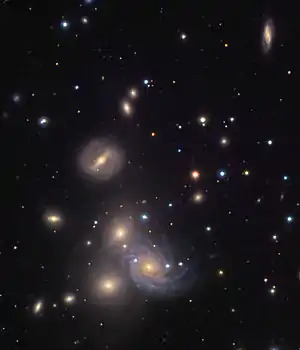NGC 68
NGC 68 is a lenticular galaxy,[5] and the central member of the NGC 68 group, in the constellation Andromeda. The galaxy was discovered on September 11, 1784, by William Herschel, who observed the NGC 68 group as a single object and described it as "extremely faint, large, 3 or 4 stars plus nebulosity".[3] As such, his reported location is between NGC 68, NGC 70, and NGC 71. By the time Dreyer looked at the galaxies to add to the NGC catalog, however, he was able to tell that the single galaxy observed by Herschel was in fact 3 adjacent galaxies, and cataloged them as NGC 68, NGC 70, and NGC 71.
| NGC 68 | |
|---|---|
 | |
| Observation data | |
| Constellation | Andromeda |
| Right ascension | 00h 18m 18.48s |
| Declination | 30° 04′ 15.4″ |
| Redshift | 0.01913[1] |
| Helio radial velocity | 5735[1] |
| Distance | 260,000,000[2] |
| Group or cluster | NGC 68 group |
| Apparent magnitude (V) | 12.9[3][4] |
| Characteristics | |
| Type | E1 |
| Size | 90,000[3] |
| Apparent size (V) | 1.288' x 1.202' |
| Other designations | |
| UGC 00170 VV 166b CGCG 499-106 CGCG 0015.7+2948 MCG +05-01-065 2MASX J00181851+3004185 WBL 007-008 USGC U012 NED07 HOLM 006A MAPS-PP O_1257_0202235C PGC 001187 SRGb 062.052 UZC J001818.4+300418 | |
References
- "NED search results for NGC 68". NASA/IPAC Extragalactic Database. Retrieved 14 May 2014.
- Wright, Ned. "Ned Wright's cosmology calculator". UCLA. Retrieved 14 May 2014.
- Courtney, Seligman. "New General Catalog Objects: NGC 50 - 99". cselingman.com. Retrieved 14 May 2014.
- "NGC 68 > Deep Sky Objects Browser". DSO browser. Retrieved 14 May 2014.
- NGC 67, 67A, 68, 69, 70, 71, 72, and 72A The Arp 113 / VV-166 Galaxy Cluster
This article is issued from Wikipedia. The text is licensed under Creative Commons - Attribution - Sharealike. Additional terms may apply for the media files.
